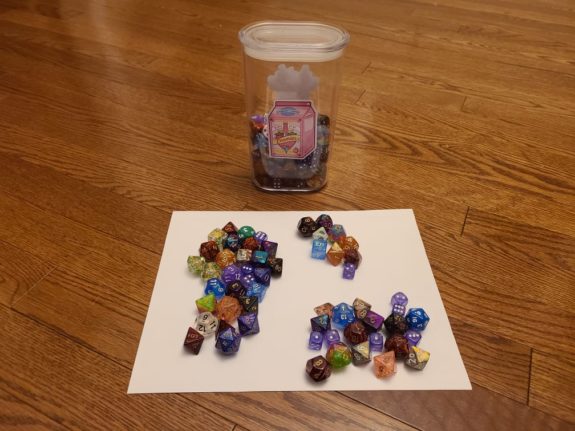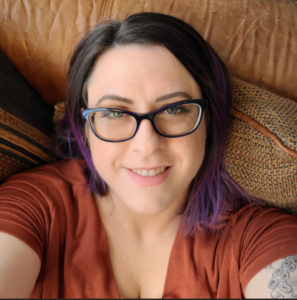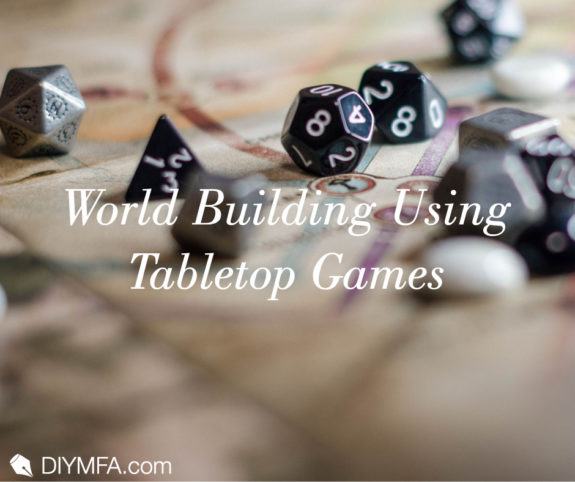We all play games. We use games to break the ice, pass the time, or as a buffer in awkward family gatherings. I use games (especially tabletop games) to make new friends, and deepen my understanding of the people in my life. Games show people at their best and at their worst. They reveal hidden talents in the people you thought you knew completely and they give us all a chance to grow.
But did you know you can use games to help with your writing? Collective storytelling games come in many forms but I find the most useful for writing are tabletop games that involve roleplaying. When running tabletop games, I put a lot of effort into world building and I want to share some ways collective storytelling games can help with your world building as a writer.
The World
When I create a campaign for my table, I have an idea of the story I want us to explore. In order to ground my players in that story, I will build a map. To build a world map I start by taking a handful of polyhedral dice and dropping them on a blank piece of paper. I trace around the dice to create the shapes of continents then add details like cities, rivers, lakes, forests and mountains. If you don’t have dice, you could use small pebbles, buttons, or coins. I highly recommend getting a set of polyhedral dice though. You can find beautiful sets of many colours and materials and they make the most satisfying sounds when rolled.

I do the same when I’m writing a story set in a world that isn’t our own. This visual representation of my world inspires me to think about how the regions interact with each other, what resources they have, and what their cultures are like. It helps to ground the movement of your characters within your world, and it’s fun to do!
Cities, towns, and settlements
Creating maps for prominent locations, like cities, helps me maintain consistency when writing in those settings. The visual aid is an easy reference to see where a certain house, tavern, or church is in relation to the rest of the city.
Recently I’ve found a really enjoyable way to create maps for cities, towns, and settlements is to play a game called The Quiet Year by game designer Avery Alder. It’s a fun and interesting game in which players take turns drawing cards from a standard 52-card deck. Each card represents a week of a standard year and comes with a prompt that encourages players to think about the community, infrastructure, and culture of a settlement. The city comes together as players add features to the settlement map, create community challenges and victories, and establish the attitudes prevalent within the community. The game is designed to help you tell the story of a community built after the collapse of society, but can be helpful to inspire the construction of locations in any setting.
This collaborative experience can be really fun to make locations in the world of your writing as well. The best way to approach the game for this purpose is to explain the way you picture your world and then give your players free rein to play the game. You don’t have to keep everything that comes out of it and they may inspire you to write something you never would have imagined otherwise!
The Campaign
Tabletop games are usually run in sections. A single game session is called an episode or an adventure. A group of game sessions that resolve one smaller part of the overarching story is called an arc. All the game sessions that make up the time the party has spent in the world you’ve created (ideally resolving the overarching plot) is called the campaign.
Campaigns are gratifying to create and run because you get to watch your friends become heroes or villains as they navigate situations they would never encounter in their real lives. You all get to explore alter egos and build empathy as you consider life from another perspective. Campaigns give you experience creating engaging conflicts for your players that you can use to help write a larger work.
If you set a campaign in the same world as the story you’re writing you’ll have to populate it with NPCs (non-player characters) that your players like to interact with. That is a great beginning to creating side characters that feel fully realized and will help you write in their voice.
While running a campaign your players will ask you questions about your world and you will have to answer them. This is an excellent way to perfect your world and add detail in corners of your world that you hadn’t thought of on your own.
Running a campaign requires that you create conflicts for your table to encounter. Your characters can face these conflicts in your writing and you can redesign them to account for loopholes or solutions your players came up with that you did not foresee.
These tools are easy to employ in fantasy works because many of the best known tabletop games are created for fantasy settings, but there are games for many genres from pulp fiction, to horror, to thriller and more.
I hope I’ve inspired some of you to try some collaborative storytelling games. I’ve loved them since middle school and I’ve found aspects of myself I may never have realized through them. I know that you’ll encounter some great people in the community of collaborative storytelling and you will deepen the friendships you already have. As a bonus, you’ll add tools to your writing toolbox that are invaluable in world building!
Have you ever used tabletop games in your writing?

Kris Hill is working on several genre fiction novels because she has difficulty sticking to writing one project at a time. In her daily life she attempts to navigate the corporate world as a data analyst. When Kris is not working, she can be found sprawled on a couch reading or running tabletop adventures for her friends. She lives in Canada’s capital city with her husband, her best friend, and four cats.







